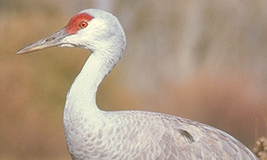|
Bird. Lesser sandhill cranes are migrating birds, and some travel as far as 22,530 km (14,000 mi) round trip! This is farther than any other crane. They fly high in the air in noisy v-shaped flocks. A crane's windpipe makes a loop inside the breastbone, creating a loud, musical rattle of a voice. Sandhill cranes paint themselves with mud during the breeding season, turning some of their gray feathers brown. They have a unique mating dance beginning with a deep bow and continuing with hops, jumps, and more bows. Adults have a wingspan of 1.8 m (6 ft) and are nearly .9 m (3 ft) tall. Their long legs are suited for wading. |
| Scientific
Name |
Lifespan |
| Grus canadensis canadensis |
12 to 15 years |
| Diet |
| Omnivore. Grain, roots, tubers, insects, grubs, crayfish, tadpoles, fish, small birds, mice, frogs, and lizards. |
| Predators and Threats |
| Young birds and eggs are preyed on by raccoons, crows, hawks, eagles, owls, ravens, wolves, coyotes, and foxes. Adults are threatened by hunters and habitat loss. |
| Habitat |
| Summer nesting grounds are in muskegs, wet tundra, and marshes of northern Canada, Alaska, and Siberia. They winter in northern Mexico, Texas, California, and New Mexico. |





